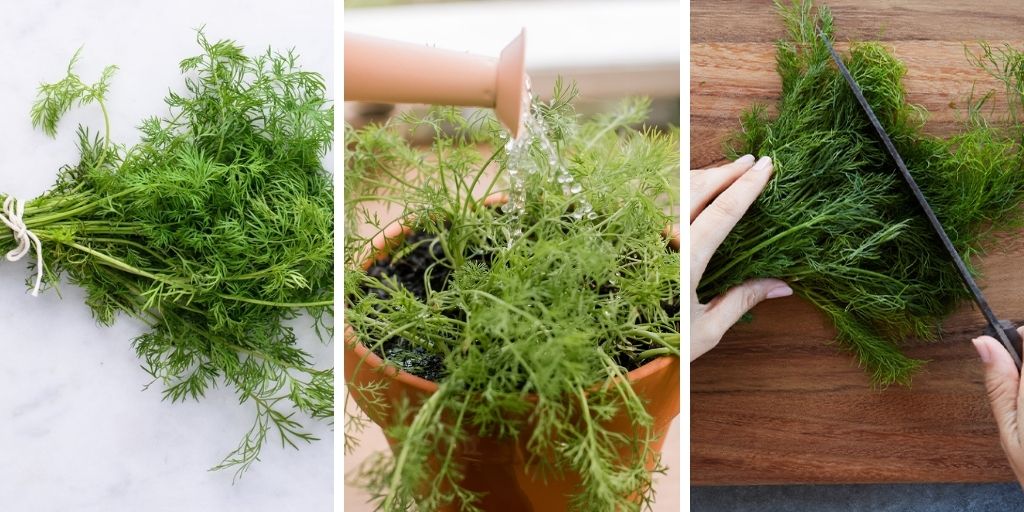Dill is a perennial herb that has feathery green fronds like a fern and known for its strong sweet aroma like licoricey and anise seeds. Although scientifically it is considered a herb and called Anethum graveolens, many people use it as a spice.
This spicy herb is easy to grow as It can self-seed and keep growing around the year. The herb reaches 2 to 4 feet tall at maturity. Its leaves can be used fresh or dried to prepare salads, vegetables, sauces, meat, seafood, fish and other dishes. As per the seeds, are used as a spice for pickling and for adding flavour to stews, roasts.stews, sauerkraut, rice, and bread.
Now, if you’re seriously considering growing this beautiful, tasty, and healthy herb and you don’t have a garden, then this article will solve your problem. This informative article will show you how to grow dill in a container.

Choose the Right Dill Variety
There are several varieties of dill but only 4 varieties are recommended to grow in containers. Of course, these varieties are also preferred for cooking as they’re known for their strong taste and aroma. Check them below and choose the right one for your needs:
- Fernleaf: This is one of the shortest Dill varieties. It does no grow longer than 18 inches. This dwarf dill does not require much space so you can grow multiple seeds in the same pot. The Fernleaf loves sun light and they need at least 6 hours of daylight to grow. They also like warm weather so they thrive best in temperature between 60-75 F (16 C to 24 C).
- Superdukat: This hybrid dill variety is one of most flavourful variety. It is suitable for container growing as its length will not exceed 24 inches. However, this plant grows slowly and does not decline easily. Besides, it is one of the varieties that give more leaves than seeds.
- Long Island Mammoth: This is the largest Dill variety in our list. This dill can grow up to a height of 36 inches with a spread around 24 inches. It’s commonly grown by commercial dill producers and thrives best outdoors. Therefore, please use a large sized container with depth that is at least 15 inches to grow this variety.
- Bouquet: This is another Large Dill variety than can grow up to 36 inches tall. This variety has bright yellow flowers that attract attention. If you want an eye-catching variety, this is the one for you.
Container, Soil, and Location
All Dill varieties have long roots. Therefore, they will need a container that will allow them to develop their roots. A 5-gallon container that is at least 15 inches deep and wide similarly will be enough to grow a couple pf plants.
Herbs are strong plants that can endure enough growing conditions including poor quality soil. However, for optimum growth, we recommend using a well-drained loamy soil. Adding aged manure or compost at the time of planting will do miracles to your plants.

As we have mentioned, these plants require at 6 hours of sunlight and the more the better. However, these plants can grow also in partial sun but will not give the results you were expecting.
Propagating and Planting
Dill usually does not grow from cuttings. Many people have tried it but the failure rate is high. However, if you’re insisting on growing them from cutting, once you have the plant, clean it with fresh water, root it in water for a couple of day then plant it in a container.
However, growing Dill for seed is the best method. Clean the seeds with fresh water and sow them directly on the container. Cover them with a light layer of soil and water them carefully keeping the soil slightly moist. The seeds should germinate within 2 weeks.
Remember, these plants love warmth. Planting them should be at least 2 months before the first frost in your region. Once the seedlings are 4 inches tall, check them, remove the unhealthy ones and leave only the good ones.
Watering, Supporting, and Fertilizing
Dill just like all herbs; they prefer the soil kept slightly moist. So, the frequency of the watering depends on how sunny your climateis. It also depends on your soil, clay soil for example dries faster than loamy soil and thus the plants will need more watering.
Dill has weak and hallow stems so if you don’t support it stacking it with a stake while it is growing, it will fall once it is tall.
You should start fertilizing you plants as soon as they’re 4 weeks old. Apply a balanced liquid fertilizer in half of its prescribed strength on the label once a month. You can make out your own fertilizer by mixing aged manure and compost.
Pruning and Caring
Pruning is required only if you’re not harvesting the herb regularly. Trim 1/3 of the branches and leaves once a month. This will promote growth and help your plant focus its energy on young healthy leaves.
Dill is prone to pests and diseases. parsley caterpillars, tomato hornworms and Aphids may attack your herb. So, keep an eye on your plants and if you observe a pest please remove it away with your hands.
Harvesting
Harvesting is the easiest step of growing and using Dill. You can start harvesting the plants as soon as it is 8 inches in height. Cut the mature green leaves and either use them while they’re fresh or dry them and grind them.
For the seeds, you can get them after 2 to 3 months when the dill flowers appear. Trim the seed heads when seeds turn flat and brown and before they fall on the ground.

The Dill is easy to grow and it is very productive and useful plant. We advise growing it and enjoying it different recipes. Please leave your questions and comments below and we will get back to you asap.

